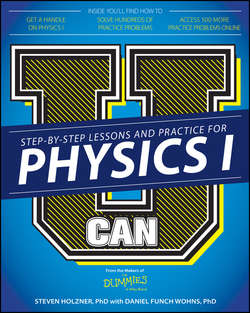Читать книгу U Can: Physics I For Dummies - Steven Holzner - Страница 14
На сайте Литреса книга снята с продажи.
Part I
Chapter 2
Reviewing Physics Measurement and Math Fundamentals
Arming Yourself with Basic Algebra
ОглавлениеPhysics deals with plenty of equations, and to be able to handle them, you should know how to move the variables in them around. Note that algebra doesn’t just allow you to plug in numbers and find values of different variables; it also lets you rearrange equations so you can make substitutions in other equations, and these new equations show different physics concepts. If you can follow along with the derivation of a formula in a physics book, you can get a better understanding of why the world works the way it does. That’s pretty important stuff! Time to travel back to basic algebra for a quick refresher.
You need to be able to isolate different variables. For instance, the following equation tells you the distance, s, that an object travels if it starts from rest and accelerates at rate of a for a time, t:
Now suppose the problem actually tells you the time the object is in motion and the distance it travels and asks you to calculate the object’s acceleration. By rearranging the equation algebraically, you can solve for the acceleration:
In this case, you’ve multiplied both sides by 2 and divided both sides by t2 to isolate the acceleration, a, on one side of the equation.
What if you have to solve for the time, t? By moving the number and variables around, you get the following equation:
Do you need to memorize all three of these variations on the same equation? Certainly not. You just memorize one equation that relates these three items – distance, acceleration, and time – and then rearrange the equation as needed. (If you need a review of algebra, get a copy of Algebra I For Dummies, by Mary Jane Sterling [Wiley].)
Example
Q. The equation for final speed, vf – where the initial speed is vi, the acceleration is a, and the time is t – is vf = vi + at. Solve for acceleration.
A. The correct answer is a = (vf – vi)/t. To solve for a, divide both sides of the equation by time, t.
Practice Questions
1. The equation for potential energy, PE, for a mass m at height h, where the acceleration due to gravity is g, is PE = mgh. Solve for h.
2. The equation relating final speed, vf , to initial speed, vi , in terms of acceleration a and distance s is vf 2 = vi 2 + 2as. Solve for s.
3. The equation relating distance s to acceleration a, time t, and speed v is . Solve for vi .
4. The equation for kinetic energy is . Solve for v.
Practice Answers
1. h = PE/mg. Divide both sides by mg to get your answer.
2. . Divide both sides by 2a to get your answer.
3. . Subtract from both sides:
Divide both sides by t to get your answer.
4. . Multiply both sides by 2/m:
Take the square root to get your answer.
